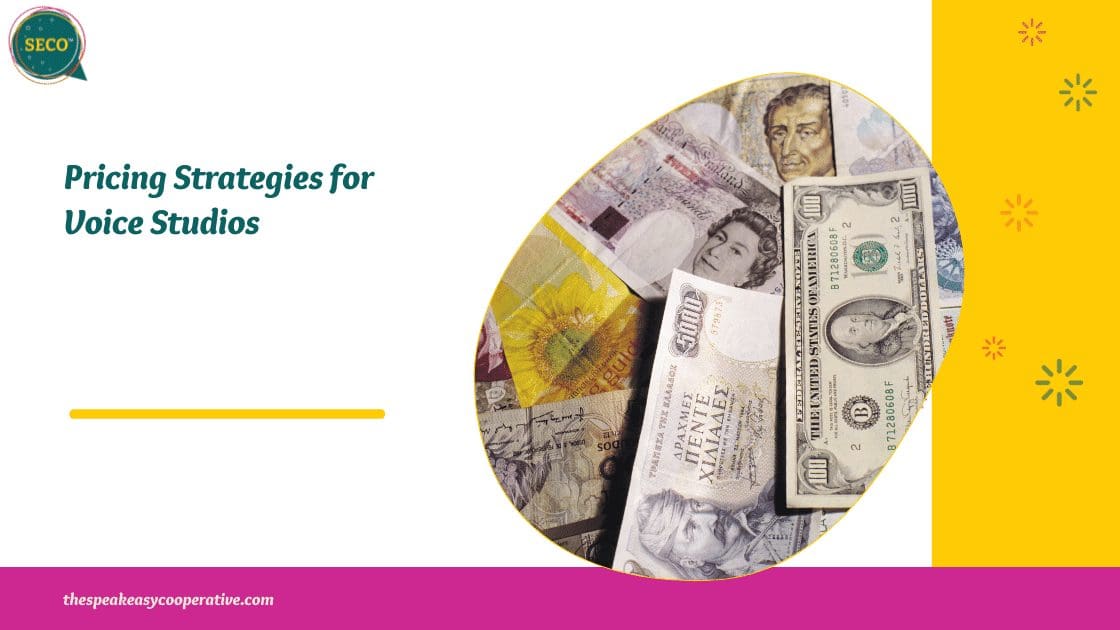In going along with the blog (What’s in your hour?) I wrote a while back, and on the heels of giving a fun presentation on pricing at this past weekend’s Vocology in Practice conference, I wrote an extra-special blog on some pricing basics. I am super proud of my title, “Wait. What? I don’t need to just pluck a price out of thin air?? NOPE. Ya don’t!” Even though it’s just awful for SEO. But I digress.
Now before you get all “Noooooooooooo, don’t make my life more complicated!”, and stop the billet doux’s and love, hear me out.
The benefit of price alignment in your voice studio
Pricing is a gateway drug. Once we get intentional about how and why we price our services the way we do, we get all warm and fuzzy inside about creating long-term business plans. We become addicted to radical self-love and radical hospitality because pricing in alignment just feels so durned good. Believe me, numbers are fun, once ya get your noggin around them.
Every voice teacher cannot be a luxury brand.
Every teacher does not want to be a luxury brand for lessons, or products, or books, or whatever.
Every teacher CAN price strategically. And, no, strategic does not mean sneaky or malicious or greedy.
Not every teacher has the same financial goals. Shoot, some teachers don’t yet have any financial goals. #nekkedtruth: In the first couple years, I sure didn’t! I was all like
“GIVE ME ALL THE STUDENTS SO I CAN PROVE I’M GOOD BUT I WON’T CHARGE ENOUGH BECAUSE I don’t trust that I know what the hell I’m doing even though I’ve been doing it for like 10 years already on the side and it’s been working great”
Oh! The myths I believed! Oh! The adopted values I egregiously implemented! I digress. Again.
I harp on pricing because it is something business owners already have in place. Many folks reading this already are selling and delivering their services and products.
I know I have a reputation. “She tells everyone to raise their rates.” In reality, I don’t. What I do work with people to do is price effectively – and for most people, that means raising their rates, because independent voice professionals so often severely uncharge, and feel stuck because they choose to have one revenue stream.
Listen, there are only three levers you can pull to make more money, friends:
- How Many [insert service or product] we sell.
- How Often we sell [insert service or product].
- How Much we sell [insert service or product] for.
Having one revenue stream is not inherently bad – yet it does potentially put a limit on your revenue.
We have to deal with pricing. And, contrary to popular belief, pricing can be revisited anytime of year – you don’t have to wait until Summer for your Fall offers, for example.
Here are the ways I have found that voice teachers tend to price – even if they don’t realize it.
(These first two aren’t my favorite):
1. Max Volume Pricing
This is when someone charges a very low fee in order to bring in as many customers as possible.
Pro: You get hella students and buyers of content! WOOT!
Con: You get hella students and buyers of content! Burnout and potential students who do not fit your vibe. Depending on the type of product, you may not get your desired ROI (Return on Investment).
2. Industry Standard Pricing
This is when someone chooses a price based on what all the folks in that industry are charging, regardless of the details of the service. For voice teachers, this usually means the local market.
Pro: You’re getting clients for who you are, and not having to explain your rates.
Con: You’re getting clients for who you are, and not getting compensated for how that means you offer a higher quality of service, more perks, a greater network, etc. There is little thought to cost of living and the budget will need to be built on what is coming in (revenue), rather than on the goals and needs of the business.
These two often get mixed and matched:
3. Hourly Pricing
I’ve come to the conclusion that many voice peeps don’t really know what this means.
Hourly should be cost plus strategy. It should be where one determines their expenses, then determines what they’d like to make for labor, and charges accordingly, in many cases, down to the minute.
In the voice teacher world, however, this usually is more like a “pay-per-service” model (see below), where people are charging for the face-to-face session only, and again, that was determined by an industry standard, rather than a true understanding of hourly pricing. If one is truly pricing at an hourly rate, they’d be charging as a lawyer would, and charging for all the minutes spent texting, emailing, rep research, competition form filling outing, etc.
Pro: If we actually did this, we’d make a really good wage.
Con: No one would pay for that. HA! Kidding! They pay. BUT, there is a lot of work that goes into finding the right clients that will pay!
4. Pay-Per-Use (or Service) Pricing
This is what most teachers call hourly (see above), but it’s not. It’s when you get paid per lesson, but not anything else.
Now, HOPEFULLY, one would charge a per-service rate that takes into account allllllllll the works (back to that “What’s in Your Hour?” post), but many do not.
Pro: TOTAL FREEDOM. People can come and go as they please, you can cancel and book as you please. Great for those who have other income streams, or a bookkeeper, or want true flexibility.
Con: Many times, the rate does not take into account the backend and admin work one is doing. There is also fret about getting paid when a service is canceled. Introduces make-ups and no-shows and cancellation policies. Causes fret. The teacher becomes a service provider only, and risks mutual respect of client. The relationship can be transactional over transformational.
My personal favs for our industry, for voice lesson pricing:
5. Tuition Model based Pricing
This is when clients are paying for services over the long-term, in one lump sum. It assumes an entire semester, or year, or whatever length you want, and is an overall cost.
Like college tuition: You pay for a semester, even though there are holidays, and you get “two excused absences”.
Pro: Built-in cancel buffers! Built-in holidays! WOOT. Cuts down on make-ups and cancellations. Easy for clients to understand. You know your income will not fluctuate. If you break it up into monthly payments, you know your monthly income is consistent.
Con: Can get complicated to keep track of sessions if you don’t have the systems in place.
Bonus! Check out my article about moving to a 12-month tuition
6. Value-Based or Flat Rate Pricing
This takes into account the value you add to the client and the scope and details of what you offer each client overall.
It is not determined by the face-to-face sessions only, but by all the extra you give your clients, whether that be time, resources, network, perks, etc. It is charged at a flat rate, a monthly retainer, or by a predetermined proposal for the scope of services. It usually involves pre-determining the scope of the project (audition prep, for example).
Pro: No more worrying about cancellation, and time, and inconsistent paychecks. The goal is the progress overall, not the check-in-the-box of a weekly session. Allows you to customize a plan and offer several options for working together, so both you and the client have an idea of what is expected. Allows clients to determine their own path and makes room for differing expectations. The potential for higher earning and deeper relationships with clients.
Con: SO MUCH WORK on the front end, if you’ve never done it before. Takes longer to find your clients, and doesn’t work as well for “out the gate”. Can be confusing to clients who are used to a pay-per-use model.
Not as much a strategy, yet worth mentioning:
7. Tiered Pricing
This is when you have a few offerings at a few different price points.
This can be implemented with any of the above strategies as well. This makes use of a great concept called price anchoring. You can read about that in the links below, but in short, “It’s easy to sell a $2,000 watch when it is sitting next to a $10,000 watch.”
Pro: More options so it allows you to serve more people and price points. Gets buyers to invest intentionally and gives them control over their spending. Helps increase revenue, since there is something to compare to.
Con: Too many levels and you confuse your clientele, works better for business ready to scale, or for products that can be easily broken into chunks… it’s hard to tier personal philosophy in private lessons.
OKAAAAAY, says you. SO WHAT?!
No matter the pricing model you choose, that is what it should be. A CHOICE.
Your pricing model should not be an accident or a, “Well that is how everyone else does it.”
It’s especially lovely to play around, on paper or a spreadsheet, with the levers I mentioned above – different structures and fees – and see what gives you the life that you want, and the studio culture you want. Then we get to talk business plans. (DO NOT FREAK OUT!)
Lastly, you all may know my “Pricing for Generosity” belief, and how sliding scale is 100000000% okay with me, as long as it’s intentional and not out of some crazy myth about people who won’t pay or some martyrdom complex.
We cannot give from lack – we can give from abundance.
And being able to gift lessons, services, and products because we are in a place of true generosity is a wonderful feeling that I highly recommend you try out once your basic needs are met.
Ah! And, also a wise idea to think through any scholarship-type offerings, to be sure they are truly felt-need-based, rather than based on any biases we may have, or assumptions around the felt needs of potential students. (Example: A student may not need you to reduce your rate. They may need you to provide a mic for them, or (when-in person) pick them up from the train station to make their commute shorter, or ally and amplify them at their school/job/gig.)
Next Steps: Further Reading on Price:
I think it’s always a good idea to get “the lay of the land” when it comes to pricing. I’m sharing these articles with you so that you have some data around pricing psychology, too. (That’s a thing.)
Information informs how we understand the conversation, and you know me, I love the conversation.
Read my academic journal
NATS Members, look up: “Battling Pricing Pitfalls: Pricing Strategy for Today’s Studio Owner”
Pricing strategies:
https://www.helpscout.net/blog/pricing-strategies/
Psychological pricing:
https://en.wikipedia.org/wiki/Psychological_pricing
The Complete guide to understand customer psychology (ch.6):
https://www.quicksprout.com/the-complete-guide-to-understand-customer-psychology-chapter-6/
After reading up on pricing, what do YOU think about pricing? How did/do you choose your prices? Are you effective in communicating value? Will you change your pricing strategy?
I’d love to know so, leave me comment below!
All My BeastyBoss,

P.S. If you’re curious on any trainings about pricing, we’ve got several inside The SpeakEasy Cooperative. If you’re a member, we can point you toward them.
P.P.S I’ve wrote about this for the Journal of Singing a while back – a more fleshed-out version of this blog – you can sign up for my mailing list here, and then reply to one of those nurture emails, and my assistant can get it to you.






0 Comments